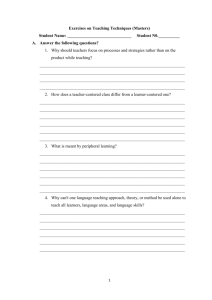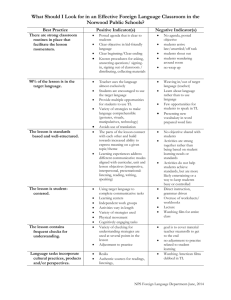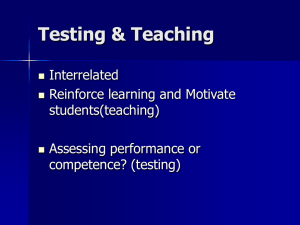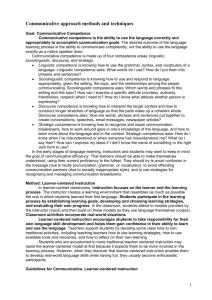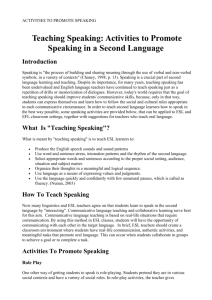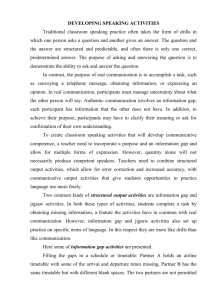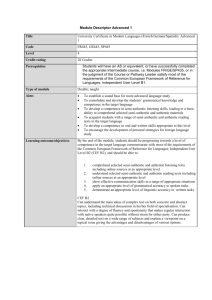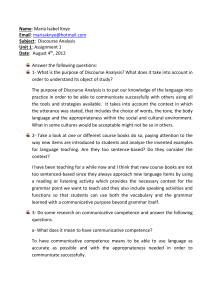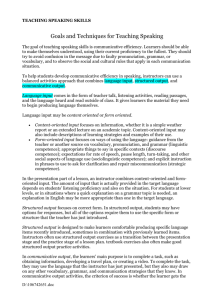Goals and Techniques for Teaching Speaking
advertisement
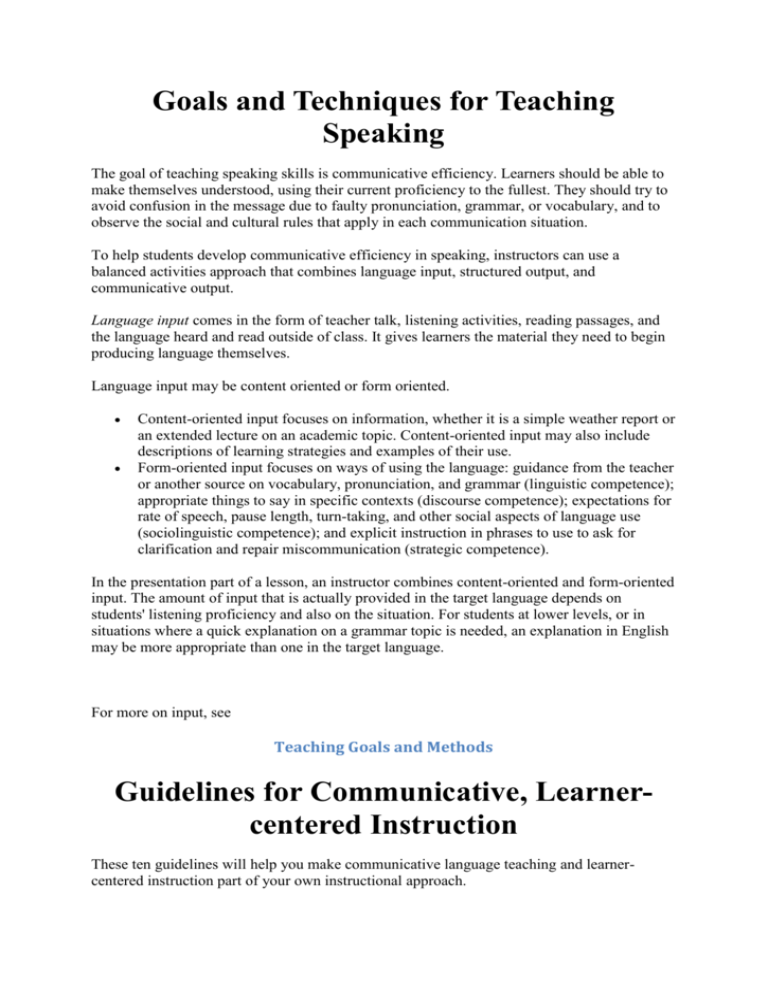
Goals and Techniques for Teaching Speaking The goal of teaching speaking skills is communicative efficiency. Learners should be able to make themselves understood, using their current proficiency to the fullest. They should try to avoid confusion in the message due to faulty pronunciation, grammar, or vocabulary, and to observe the social and cultural rules that apply in each communication situation. To help students develop communicative efficiency in speaking, instructors can use a balanced activities approach that combines language input, structured output, and communicative output. Language input comes in the form of teacher talk, listening activities, reading passages, and the language heard and read outside of class. It gives learners the material they need to begin producing language themselves. Language input may be content oriented or form oriented. Content-oriented input focuses on information, whether it is a simple weather report or an extended lecture on an academic topic. Content-oriented input may also include descriptions of learning strategies and examples of their use. Form-oriented input focuses on ways of using the language: guidance from the teacher or another source on vocabulary, pronunciation, and grammar (linguistic competence); appropriate things to say in specific contexts (discourse competence); expectations for rate of speech, pause length, turn-taking, and other social aspects of language use (sociolinguistic competence); and explicit instruction in phrases to use to ask for clarification and repair miscommunication (strategic competence). In the presentation part of a lesson, an instructor combines content-oriented and form-oriented input. The amount of input that is actually provided in the target language depends on students' listening proficiency and also on the situation. For students at lower levels, or in situations where a quick explanation on a grammar topic is needed, an explanation in English may be more appropriate than one in the target language. For more on input, see Teaching Goals and Methods Guidelines for Communicative, Learnercentered Instruction These ten guidelines will help you make communicative language teaching and learnercentered instruction part of your own instructional approach. 1. Provide Appropriate Input Input is the language to which students are exposed: teacher talk, listening activities, reading passages, and the language heard and read outside of class. Input gives learners the material they need to develop their ability to use the language on their own. Language input has two forms. Finely tuned input Is matched to learners’ current comprehension level and connected to what they already know Focuses on conscious learning of a specific point: the pronunciation of a word, the contrast in the uses of two verb tenses, new vocabulary, useful social formulas Is controlled by the instructor or textbook author Is used in the presentation stage of a lesson Roughly tuned input Is more complex than learners’ current proficiency and stretches the boundaries of their current knowledge Focuses on authentic use of language in listening or reading passages Is used “as is,” with minimal alteration by the instructor or textbook author Is used in the activity stage of the lesson Roughly tuned input challenges student to use listening and reading strategies to aid comprehension. When selecting authentic materials for use as roughly tuned input, look for listening and reading selections that are one level of proficiency higher than students’ current level. This will ensure that students will be challenged by the material without being overwhelmed by its difficulty. 2. Use Language in Authentic Ways In order to learn a language, instead of merely learning about it, students need as much as possible to hear and read the language as native speakers use it. Instructors can make this happen in two ways. Teacher talk: Always try to use the language as naturally as possible when you are talking to students. Slowing down may seem to make the message more comprehensible, but it also distorts the subtle shifts in pronunciation that occur in naturally paced speech. Speak at a normal rate Use vocabulary and sentence structures with which students are familiar State the same idea in different ways to aid comprehension Materials: Give students authentic reading material from newspapers, magazines, and other print sources. To make them accessible, Review them carefully to ensure that the reading level is appropriate Introduce relevant vocabulary and grammatical structures in advance Provide context by describing the content and typical formats for the type of material (for example, arrival and departure times for travel schedules) Advertisements, travel brochures, packaging, and street signs contain short statements that students at lower levels can manage. The World Wide Web is a rich resource for authentic materials. Reading authentic materials motivates students at all levels because it gives them the sense that they really are able to use the language. 3. Provide Context Context includes knowledge of the topic or content the vocabulary and language structures in which the content is usually presented the social and cultural expectations associated with the content To help students have an authentic experience of understanding and using language, prepare them by raising their awareness of the context in which it occurs. Ask them what they know about the topic Ask what they can predict from the title or heading of a reading selection or the opening line of a listening selection Review the vocabulary (including idiomatic expressions) and sentence structures that are usually found in that type of material Review relevant social and cultural expectations 4. Design Activities with a Purpose Ordinarily, communication has a purpose: to convey information. Activities in the language classroom simulate communication outside the classroom when they are structured with such a purpose. In these classroom activities, students use the language to fill an information gap by getting answers or expanding a partial understanding. For example, students work in pairs, and each is given half of a map, grid, or list needed to complete a task. The pair then talk to each other until they both have all the information. 5. Use Task-based Activities Fluent speakers use language to perform tasks such as solving problems, developing plans, and working together to complete projects. The use of similar task-based activities in the classroom is an excellent way to encourage students to use the language. Tasks may involve solving a word problem, creating a crossword puzzle, making a video, preparing a presentation, or drawing up a plan. 6. Encourage Collaboration Whenever possible, ask students to work in pairs or small groups. Give students structure in the form of a defined task and outcome. This structure will allow students to collaborate as they develop a work plan, discuss the substance of the task, and report the outcome. They will thus use language in a variety of ways and learn from each other. Effective collaborative activities have three characteristics. Communication gap: Each student has relevant information that the others don’t have Task orientation: Activity has a defined outcome, such as solving a problem or drawing a map Time limit: Students have a preset amount of time to complete the task 7. Use an Integrated Approach Integration has two forms. Mode integration is the combination of listening, speaking, reading, and writing in classroom activities. By asking students to use two or more modes, instructors create activities that imitate real world language use. Content integration is bringing content from students’ fields of study into the language curriculum. University students often find it instructive to read, discuss, and write about material whose content they already know, because their knowledge of the topic helps them understand and use the language. They are able to scaffold: to build on existing knowledge as they increase their language proficiency. For students who plan to study and/or work in a field that will require them to use the language they are learning, integration of content can be a powerful motivator. 8. Address Grammar Consciously University students usually need and appreciate direct instruction in points of grammar that are related to classroom activities. These students often have knowledge of the rules associated with standard use of their native language (metalinguistic knowledge) and can benefit from development of similar knowledge in the target language and discussion of similarities and differences. Discuss points of grammar in the contexts where they arise. Asking students to think through a rule in the context of an effort to express themselves clearly is a more effective way of helping them internalize the rule than teaching the rule in isolation. Two types of grammar rules to address when using authentic materials: Prescriptive rules: State how the language “should” or “must” be used; define what is “correct.” These are the rules that are taught in language textbooks. Descriptive rules: State how the language is actually used by fluent speakers. The degree to which descriptive rules differ from prescriptive rules depends on the setting (casual/formal use of language), the topic, and the backgrounds of the speakers. 9. Adjust Feedback/Error Correction to Situation In the parts of a lesson that focus on form direct and immediate feedback is needed and expected. Encourage students to self-correct by waiting after they have spoken or by asking them to try again. Feedback techniques: Paraphrase a student's utterances, modeling the correct forms Ask students to clarify their utterances, providing paraphrases of their own Avoid feeding students the correct forms every time. Gradually teaching them to depend less on you and more on themselves is what language teaching is all about. In the parts of a lesson that focus on communication activities, the flow of talk should not be interrupted by the teacher's corrections. When students address you, react to the content of their utterances, not just the form. Your response is a useful comprehension check for students, and on the affective level it shows that you are listening to what they say. Make note of recurring errors you hear so that you can address them with the whole group in the feedback session later. 10. Include Awareness of Cultural Aspects of Language Use Languages are cognitive systems, but they also express ideas and transmit cultural values. When you are discussing language use with your students, it is important to include information on the social, cultural, and historical context that certain language forms carry for native speakers. Often these explanations include reference to what a native speaker would say, and why. Culture is expressed and transmitted through magazines and newspapers, radio and television programs, movies, and the internet. Using media as authentic materials in the classroom can expand students’ perspectives and generate interesting discussions about the relationships between language and culture. Structured output focuses on correct form. In structured output, students may have options for responses, but all of the options require them to use the specific form or structure that the teacher has just introduced. Structured output is designed to make learners comfortable producing specific language items recently introduced, sometimes in combination with previously learned items. Instructors often use structured output exercises as a transition between the presentation stage and the practice stage of a lesson plan. textbook exercises also often make good structured output practice activities. In communicative output, the learners' main purpose is to complete a task, such as obtaining information, developing a travel plan, or creating a video. To complete the task, they may use the language that the instructor has just presented, but they also may draw on any other vocabulary, grammar, and communication strategies that they know. In communicative output activities, the criterion of success is whether the learner gets the message across. Accuracy is not a consideration unless the lack of it interferes with the message. In everyday communication, spoken exchanges take place because there is some sort of information gap between the participants. Communicative output activities involve a similar real information gap. In order to complete the task, students must reduce or eliminate the information gap. In these activities, language is a tool, not an end in itself. In a balanced activities approach, the teacher uses a variety of activities from these different categories of input and output. Learners at all proficiency levels, including beginners, benefit from this variety; it is more motivating, and it is also more likely to result in effective language learning.
